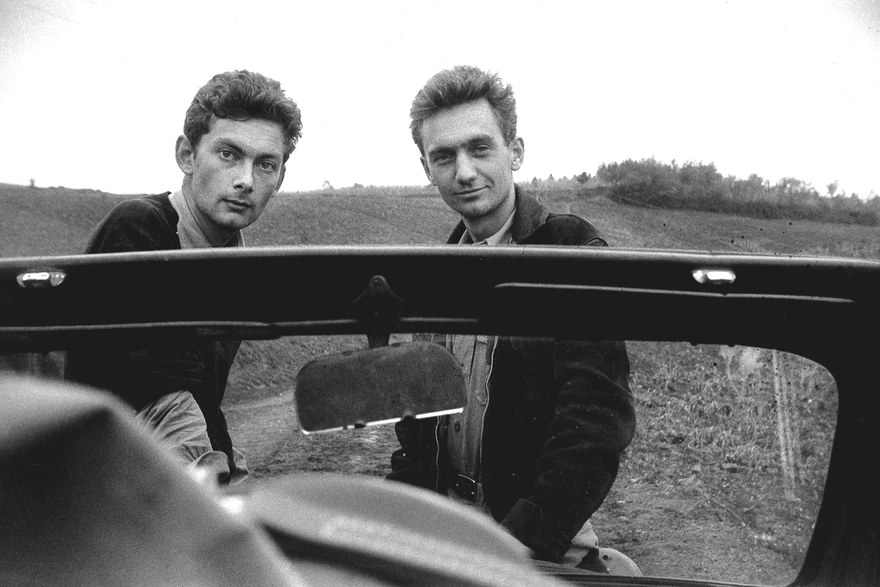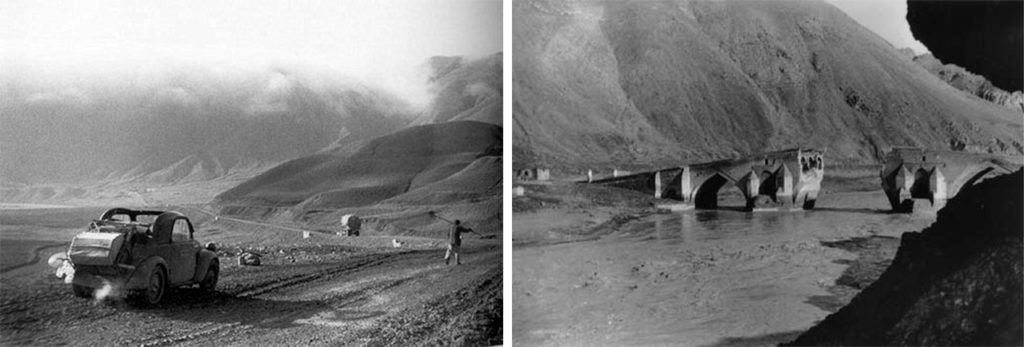Writer, poet, iconographer and photographer, Nicolas Bouvier has many facets. But each of these occupations is fueled by a single passion: travel. If he were alive today, Nicolas Bouvier would surely be described as a digital nomad, sharing his stories, road photographs, music and emotions on the internet. In his own time, he became the vanguard of travel writing with his logbooks, the sketches of his friend Thierry Vernet and the iconography salvaged from library shelves. Put down on paper years later, his adventures have become invitations to exploration and discovery for a whole generation of readers.

The nomadic spaces Swiss
To understand Nicolas Bouvier’s art of travel and cosmopolitan lifestyle, you have to start in Geneva. It was 1929, the year the last child of the Bouviers was born in Grand-Lancy. His father, Auguste-Adolphe Bouvier, was a librarian, while his mother, Antoinette Maurice, came from a family of musicians. Nicolas’ childhood was thus cradled by letters and notes, sometimes on the Côte with his paternal grandfather Bernard Bouvier, a professor at Geneva University, sometimes in Allaman with his maternal grandfather Pierre Maurice, a composer. Through hours and hours of reading, young Nicolas developed a passion for everything from painting to geographical atlases, from Swiss landscapes to stories from overseas, from linguistics to political discussions. And he dreams, following in the footsteps of Croc-Blanc, carried away by the turmoil of Phileas Fogg’s adventures or embarking on the ship Hispaniola with Jim Hawkins in search of Treasure Island.
After graduating from the Brechbühl school, which later became Collège de Genève, he went on to study literature and law at the University of Geneva. But Switzerland became too small for his dreams. Encouraged by his father, he took to the road, or rather the roads. His first journeys took him to the Mediterranean, Lapland in the north, southern Africa, the Balkans and Istanbul. As the roads and destinations followed one another, his circle of escapism expanded. Buoyed by his love of discovery, he began to document his first contemplations. These were only intimate notes and early personal texts, but he began to grasp the meaning of travel and the world. At the same time, he published some of his texts in newspapers, giving a reportage aspect to his travels. This was only a prelude to his future years. Symbolically, he is already on the road to his first long journey, when he graduates. The first chapter has thus begun!

Between orientalism and nipponism
Devoured by curiosity about everything, his first major crossing took him from Yugoslavia to Afghanistan. It was this very first journey, with its countless encounters, discussions, exchanges and cultural anecdotes, that made him an uprooted author-traveler, and became the genesis of his book L’Usage du monde, published in 1963. He recounts these discoveries through chronologies, descriptions of stages, commentaries, maps and sketches. But let’s not get ahead of ourselves: in 1953, Nicolas Bouvier decided to set off again with his friend and illustrator Thierry Vernet. Together, they loaded their belongings into a Fiat Topolino, which would serve as their home for the next few months. The journey is planned in the footsteps of ancient civilizations, between mythology and anthropology. Belgrade, Constantinople, Giresun, Maku, Teheran, Kerman, Kandahar – what exotic names await them! Although their savings enabled them to get started quickly, the two friends then had to earn a living on the spot. As Bouvier used to say, they moved even more slowly than Marco Polo! But the two travel companions relish this slowness. This moderate pace allows them to take their time, time to make passing friends, time to mingle, time to immerse themselves in the culture, time to become part of the colorful landscape. Time, too, to put down on paper, in words or pencil strokes, these emotions, imprints and memories, even to question Western civilizations and European realities. This duo adventure came to an end in Ceylon in 1955. While his faithful friend married and returned to Switzerland, Nicolas decided to continue his journey to India. Alone.

If the first part of the journey was light, almost poetic, Nicolas Bouvier was to put down roots for almost seven months on this island in the middle of the Indian Ocean. Nailed down by heat, illness, loneliness, sadness and even the madness of unreason, he never found the strength to leave again. Almost three decades later, immersed in a library, he finally forged the words of this rather pivotal period in Le Poisson-scorpion. But let’s stay with his journey.
Finally, in 1955, he boarded a French liner for a new island, Japan. The atmosphere and feeling were different, and he became fascinated by the Land of the Rising Sun. Writing for the local press, he began photographing. Although his first shots were quite commercially motivated (photography is universal and, unlike articles, he didn’t have to pay a translator), he developed a passion for this new way of documenting. Unsurprisingly, it’s the portrait that fascinates him. “The human face is wonderfully rich. First of all, no two are alike, are they? And secondly, the range of what a face can express is inexhaustible”, he says in an interview. And he immortalized the real people of the city and countryside, with their unique expressions and eyes full of life stories. And it’s also the end of his expedition to the other side of the world. This last leg of his journey was published as Chronique japonaise in 1975.

“Everything came to me through travel”.
After these years of exile and wandering adventures, Nicolas Bouvier changed his lifestyle and settled in Geneva. Married to Éliane Petitpierre and the father of two children, he was first drawn to the peacefulness of Colony, then haunted by the destructive nostalgia of his travels. In the end, it was perhaps the desire to relive his experiences once again by putting them down on paper that enabled him to turn the page… even if not for very long. His writings met with limited success when they were first published, and Nicolas Bouvier concentrated on other activities. He made appearances in the media, worked in the WHO archives, contributed to the Red Cross museum, and so on. But his travels gradually resumed, both in Asia and in Europe. As François Laut, his biographer, wrote, Nicolas Bouvier “has travel in him, with trips to see and returns to write”. He went on to publish a number of books recounting his new life experiences, such as Journal d’Aran et d’autres lieux. His reputation gradually grew, with awards and an invitation to the 1970 World’s Fair, but the 90s marked the real apogee of his work. The man who had sought out the literary tradition of the travelogue was to be recognized for his travel writings and his sensitivity to the world! But in the slowness so much appreciated by the Genevan, the time of the last journey approached. After the death of his travelling companion in 1993, the writer-traveller died in 1998, leaving behind him unpublished notebooks, chronicles of his last journeys, and intellectual and photographic discoveries. Some of these will be on display at the exhibition Nicolas Bouvier. Le vent des routes, organized by MEG in Geneva in his honor, and others in broadcasts, discussions and publications. The next meeting with the writer-traveler will surely be at the Théâtre de Carouge in November 2023. Directed by Catherine Schaub and performed by Samuel Labarthe, the play recounts his first journeys at the wheel of his Fiat Topolino. As the car moves forward, so does the story.

“People don’t travel because when you travel, you load yourself up with memories, you lose feathers, you lose illusions, you come back thinner every time and, above all, you lose the alibis, the alibis you have in a sedentary life. Instead of facing up to our own mediocrity, we always have the option of blaming society. It’s the cops’ fault or the bosses’ fault or the workers’ fault or the system’s fault. When you travel, it’s your fault.” Nicolas Bouvier, RTS



